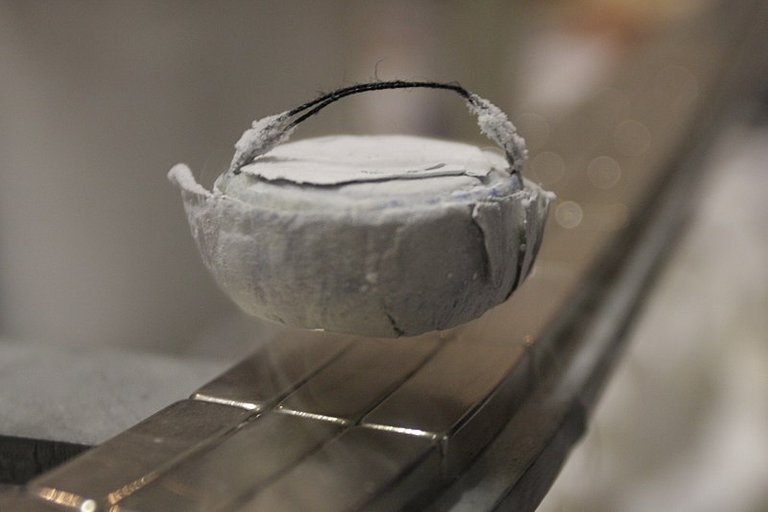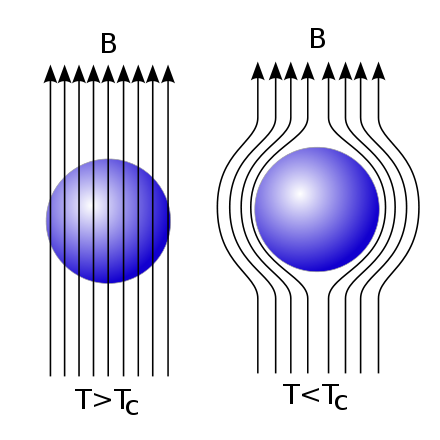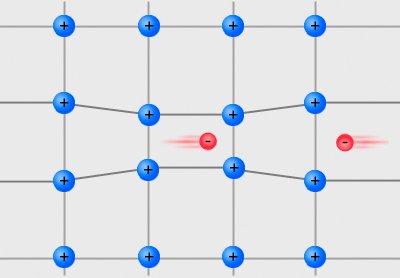Hello, Steemian! I'm glad to be writing on this great platform once again. A big thanks to you all for reading, commenting and upvoting my recent posts. My subject of discussion today is on an explanation of Superconductivity, YPtBi- being the newly discovered type of Superconductors and their applications.
Introduction
Taking my country, Nigeria as a case study, I noticed that copper wires are mostly used in power transmissions, electrical installations, and in-house wirings. Then, a transformer is used to step up or down the voltage flowing through it. I also noticed that a large percentage of energy is lost as heat from the cables used in transmitting the power because when an electric current flows through a copper wire, the electrons moving through it will start to hit the electrons inside the nucleus of the copper atoms consecutively, thereby causing heat. That heat in itself is electric current which is lost during the movement of electrons inside the copper wire.
Imagine a situation whereby a material with no resistance is used to transmit power. Let's say a 30kV is transmitted along such a material, that means exactly 30kV would reach its final destination. There will be no case of heat loss, the power will be transmitted very fast and the cost of generating and also transporting such a power will be greatly reduced, amongst other benefits. That strange material that allows electric power to flow easily through it, with no resistance is called a "Superconductor" and the process by which it occurs is known as "Superconductivity"

Author:Henry Mühlpfordt; CC BY-SA 3.0, 2.5, 2.0, 1.0licensed
What is Superconductivity?
Superconductivity is the distinguishing feature of a solid showing no electrical resistance when cooled below a certain temperature called transition temperature. Solids exhibiting such superconducting behavior are regarded to as Superconductors and can only possess that rare attribute when cooled below the temperature range of 20 K (−253 °C).
The phenomenon of Superconductivity is very closely related to that of Superfluidity, except that the zero viscosity in superfluidity is being replaced by zero electrical resistance in superconductivity. And aside the fact that superconductors have no electrical resistance, they also repel magnetic flux fields.
How was Superconductivity discovered?
Superconductivity was discovered by a Dutch physicist named Heike Kamerlingh Ones in the year 1911. He performed an experiment using a mercury wire and noticed that its electrical resistance vanishes as soon as it was cooled below a temperature of 4K (−269 °C)which is a lil bit above the absolute zero temperature.
Also from that same experiment, Heike discovered that he could turn the mercury wire back to the normal (original) state it was before being subjected to intense cooling. He was able to achieve that feat by either allowing a significant large amount of electric current to flow through the mercury wire or by making a strong magnetic field to pass through it.
Meissner effect
Superconductors are diamagnetic in nature and they have the ability to strongly repel magnetic flux field. The phenomenon that really explains this characteristics of a superconductor is known as the Meissner effect.

Author: Piotr Jaworski; public domain Licensed.
It's a great discovery named after one of its two discoverers. What "Meissner effect" is making us to understand is that whenever a superconducting material is cooled in a magnetic field to a temperature very close to absolute zero where superconductivity takes place, there is going to be a total expulsion of magnetic flux from within the superconducting material.
This great discovery of Meissner gave birth to a new theory known as the electromagnetic characteristics of superconductors which made it possible to predict the occurrence of how deep an electromagnet can penetrate a superconductor. It was not until 1950 when it was shown for the first time that the theory of superconductivity must also address the issue of free electrons in a crystal.
Just like I've explained above about how the relationship between the movement and constant collision of electrons in a conductor brings about heat loss, so also is the free electrons in a crystal are being affected by the vibrations of atoms within the crystals and such vibrations are called the lattice vibrations.
Normally, in metals, the energies of their free electrons are observed to being distributed equally, but in the year 1951 it was observed that the reverse was the case of a superconductor and rather there was a separation called the energy gap
The BCS theory
For some decades after the discovery of Kamerlingh, scientists were unable to come up with a basic theory of superconductivity, not until 1957 when three physicist from United States named John Bardeen, Leon N. Cooper, and John Robert Schrieffer came up with a theory. The theory, which later won for the scientists a Nobel Physics prize in 1972, is popularly known as the BCS theory named after the initials of the three American scientists.
This theory set the stage for its earlier model which was brought up in 1950 by two Russian physicists named Lev Davidovich Landau and Vitaly Lazarevich Ginzburg. The BCS theory explains the process by which a current of electron pairs flows in some conductors without any electrical resistance at low temperatures, as a microscopic effect caused by a condensation of a pair of electrons with opposite spin resembling a boson.
Through this BCS model, some properties such as that of the electromagnetic and magnetic flux existing within a superconductors can be easily understood. It also gives an insight on the effect such properties have on a superconductor, an effect known as the quantization of magnetic flux.
A British physicist named Brian D. Josephson foretold in the year 1962 that a superconductor will exhibit some electromagnetic characteristics whenever it's in contact with electricity. And truly, it was later observed after some years that his prediction was right through some series of experiments such as the low-frequency infrared absorption and ultrasonic absorption that was later carried out. All these experiments were done so as to understand the different properties of superconductor.
What are the Thermal Properties Of Superconductors
There's a big difference in how normal conductors behave to how a superconductor behaves. Some of the difference in behavior is very evident in how the two separate materials conduct electricity. Some of the electrons inside a normal conductor are free to move about without attaching to any particular atom and the result of those movement brings about an electric current. These free moving electrons can easily be scattered by some process such as grain boundary, impurities, dislocations and phonons.
In a superconductor likewise, there are free moving electrons called conduction electrons that also bring about electric current. But those conduction electrons are not scattered by any of the process written above because of how the electrons in a superconductor are arranged (Cooper pairs) which thereby allows the easy passage of electrons without any resistance.

Author: Tem5psu; CC BY-SA 4.0Licensed.
Cooper Pairs
Cooper pairs explains more on the momentum of electrons rather than their individual location. The energy attributed to an electron in Cooper pairing is relatively small, to an extent that it's much more smaller than energy per electron of a spontaneous chemical reaction. Little wonder the theories of superconductor remained elusive all this while, it's as a result of the small energy per electron in changing from a normal conductor state to a superconducting one. Even the few theories that was so fortunate to be propounded before that of the BCS were incorrect.
Transition temperatures of a Superconductor
From the word transition, it means change from one place or form to another. So, a transition temperature of a superconductor can said as a temperature below which a non-superconducting material changes to become superconducting or behaves as a superconductor. It is denoted by Tc. From the year 1986, it was observed that some compounds of copper and oxygen otherwise known as Cuprates, to have higher transition temperature and the characteristics of such a compound greatly differ to the set of classic superconductors known before 1986. Aside the Cuprates, there are other compounds of carbon called fullerenes and fullerides that are also superconducting but with very high transition temperatures.
But, of all the known superconductors, tungsten has 0.015K, which happens to be lowest transition temperature ever. The element with the highest transition temperature is Niobium, with a temperature of 9.2K. Presence of magnetic impurities have been observed to have effect on transition temperatures of superconductors. The more the impurities, the lower the transition temperature vice versa.
Types of Superconductor
There are two main types of superconductor. They are referred to as the type I and type II superconductor. Type I superconductors are generally the normal superconductors having no electrical resistance and magnetic field while the type II mostly comprises of alloys or compounds and they are found to be harder than the type I. An example of type II superconductor is the niobium-titanium (NbTi).
%20(1).png)
Author: Eynar public domainLicensed
Examples of Superconductors
It's so amazing that out of the few hundreds of materials that are known to be superconducting at low temperatures, only twenty-seven of them are superconductors. Firstly, those 27 materials are metals and secondly they are only superconducting as crystals at very low temperature and atmospheric pressure. Examples of such metals are Mercury (Hg), Tin (Sn), Lead (Pb), Aluminium (Al) and Lanthanum (La)
There are some elements too that are superconducting at low temperatures but at high pressures. Examples are Silicon (Si), Uranium (U), and Selenium (Se). There are also some that are naturally non-superconducting in their crystalline form but can be made superconducting by rearranging their ordered pairs of electrons. An example is Bismuth (Bi). While some elements such as Cobalt (Co), Chromium (Cr), Nickel (Ni), Iron (Fe), and Manganese (Mn) even despite their magnetic properties show no characteristics of superconductivity in them.
Another interesting angle about superconductivity is that a compound or alloy can be made superconducting while it's partaking elements standing ordinarily alone are not even superconducting. A very typical example of this is a lower stage Carbon-Potassium compound (C8K) and Silver subfluoride (Ag2F). Also Tin telluride (SnTe), a semiconductor can also be made superconducting by adding some impurities to the compound.
YPtBi; the recently discovered Superconductor
What is very common to superconductors is their ability to allow electric current to flow through it without any resistance when they are subjected to a very low temperature close to absolute zero. Their usefulness has really been immense in the world and some of which is evident in the making of magnetic levitating train and MRI machines. But, despite all these advantages, there still pose a major problem to superconductivity. The problem is the expensive cost of equipment in making the superconductors to be very efficient enough at such a low temperature.
Although many researches have been ongoing to surmount the problem, albeit the progress is somehow slow. Not until recently, a group of researchers at the University of Maryland, made a surprise breakthrough. They discovered a rare superconductor like never before named YPtBi, which opens the door for a new world of areas and ideas that's never been considered before.

Author: Tem5psu; CC BY-SA 4.0Licensed.
The physicists stumbled across the superconductor while exploring a foreign material at low temperatures. It was found that this new superconductor depends on electron-pair interaction different from that of the Cooper pairs we are familiar with.
Electron-pair interaction is always controlled by a property of quantum mechanics called spin. The electrons in a normal superconductor always have a spin of 1/2 while that of YPtBi is kind of strange with a spin of 3/2. Even a physicist named Johnpierre Paglione said that this characteristics found in YPtBi has never been thought to could have happened in a solid material because when the atoms of a solid is broken down to parts, it tends to carry 1/2 spin.
The discovery of YPtBi
YPtBi is a semimetal found to be superconducting at a transition temperature (Tc) of 0.77K. It was discovered as a superconductor some few years back although the material didn't have the attributes of a superconductor because of the presence of few mobile electrons at a relatively normal temperatures.
In theory, to make a material such as YPtBi superconducting at a temperature below 0.8K, more mobile electrons up to a few thousands would be needed. But as soon as the material was cooled down, it started to exhibit the characteristics of a superconductor.
Normally, a superconductor expels magnetic field just like I've explained above. So, to test what's exactly going on inside the material YPtBi, it was made to be in contact with a magnetic field and wow! By jove! A surprise happened. It was noticed that as the temperature is increased from the initial temperature it was before i.e the absolute zero, the rate at which magnetic field penetrates the material increased linearly instead of rapidly as commonly seen in regular superconductors. In looking for the reason why such happened, it was later got to know that the electrons inside the material assumed the role of an higher spin particles.
Finally, according to the researcher, Hyunsoo Kim, he said:
The discovery has given the whole concept of superconductivity a new dimension and there's still a lot to be explored in the new material. And the most beautiful part is the fact that there's now a new type of superconductivity to work with out of over a hundred years of research of this type. source
Applications of Superconductors
Superconductors have a lot of applications, some of which are in the medical magnetic-imaging devices, MRI (Magnetic Resonance Imaging) and NMR (Nuclear Magnetic Resonance) machines.

Author: Nevit Dilmen (talk); CC BY-SA 3.0
They are also useful in the magnetic energy-storage systems, mass spectrometer and in magnetic separation in the pigment industries.
Superconductors are used in the making of the powerful electromagnetic ever known. A process used in the making of vactrains and magnetic levitating trains (maglev).
Of recent, Superconductors are used in the production of digital circuits and microwave filters in telecommunications companies.
Superconductors are also used in the building of Josephson junctions which are majorly applied in SQUIDs
The future use of superconductors are in the high efficiency power transformer, generators, storage devices and in enhancing spintronic devices.
They are also used in the production of high sensitive devices used in measuring current, voltage and magnetic field.
Finally, superconducting transmission lines are very efficient in transmitting power as compared to the primitive transmission lines. Also, the superconducting lines don't take much space and they are environmental friendly.
Thanks for reading
References
Types of Superconductors
Definition of Superconductivity
Definition of Superconductivity
http://electron6.phys.utk.edu/qm2/modules/m5-6/flux.htm
https://en.m.wikipedia.org/wiki/Energy_gap
Thanks. Very interesting post.
You are welcome. I'm glad you found it interesting. Thanks for passing by.
This post has been voted on by the steemstem curation team and voting trail.
There is more to SteemSTEM than just writing posts, check here for some more tips on being a community member. You can also join our discord here to get to know the rest of the community!
Hi @emperorhassy!
Your post was upvoted by utopian.io in cooperation with steemstem - supporting knowledge, innovation and technological advancement on the Steem Blockchain.
Contribute to Open Source with utopian.io
Learn how to contribute on our website and join the new open source economy.
Want to chat? Join the Utopian Community on Discord https://discord.gg/h52nFrV
Let me guess, you ate taking us on a series of the supers lol.
I am not a physics person, but I have picked the simple parts of this "series".
Superfluidity- Zero viscosity (from last post)
Superconductivity - Zero resistance.
Great post buddy!...
You garrit, bro. World of the Supers, lol.
I'm very happy you were able to pick the salient points in my two posts and you got them just right.
Thanks for passing by jare padi mi, gbefun gbefun.
Hehhahe... Oya gbefun gbefun
The pleasure was mine bro.
I was actually thinking of them being the Lagos Agberos until now 😂
Great post boss!
Hahahahahaha..... Those ones in lag are bus conductors, they allow passengers free flow inside the buses without hindrance. Lol while my post is about superconductors, they allow free flow of electrons inside a material without stress. Lol
Thanks for passing by, bro.
Congratulations! This post has been upvoted from the communal account, @minnowsupport, by emperorhassy from the Minnow Support Project. It's a witness project run by aggroed, ausbitbank, teamsteem, theprophet0, someguy123, neoxian, followbtcnews, and netuoso. The goal is to help Steemit grow by supporting Minnows. Please find us at the Peace, Abundance, and Liberty Network (PALnet) Discord Channel. It's a completely public and open space to all members of the Steemit community who voluntarily choose to be there.
If you would like to delegate to the Minnow Support Project you can do so by clicking on the following links: 50SP, 100SP, 250SP, 500SP, 1000SP, 5000SP.
Be sure to leave at least 50SP undelegated on your account.
Congratulations @emperorhassy! You have completed the following achievement on Steemit and have been rewarded with new badge(s) :
Click on the badge to view your Board of Honor.
If you no longer want to receive notifications, reply to this comment with the word
STOP